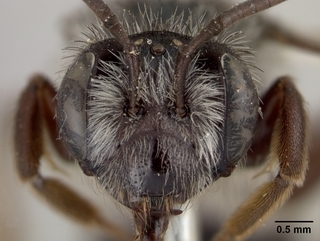
Smithsonian Institution, Entomology Department · 9
Andrena peckhami, female, face |
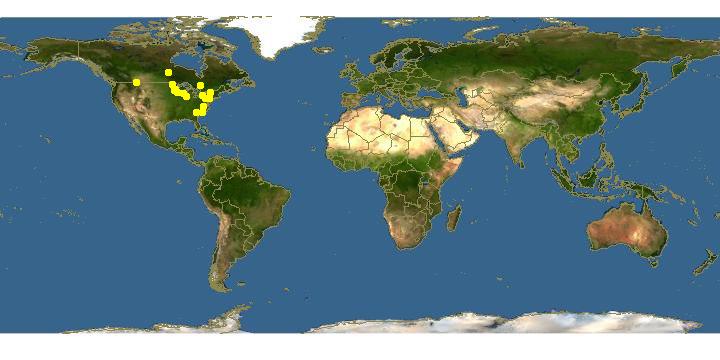
Click on map for details about points.
|
80x5 -
240x3 -
240x4 -
320x1 -
320x2 -
320x3 -
640x1 -
640x2
Set display option above.
Click on
images to enlarge. |
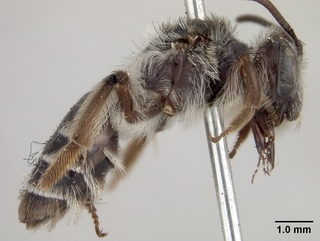
Smithsonian Institution, Entomology Department · 9
Andrena peckhami, female, side |
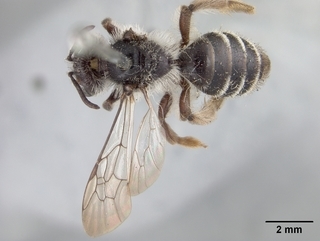
Smithsonian Institution, Entomology Department · 9
Andrena peckhami, female, top |
|
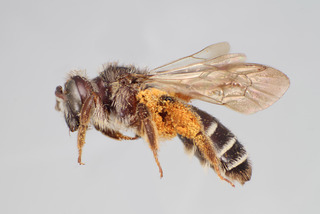
© Copyright Laurence Packer 2014
· 7
Andrena peckhami FEM CFP- |
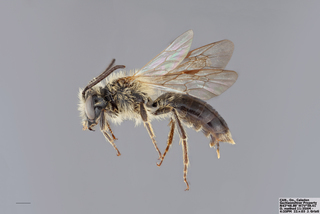
© Copyright Laurence Packer 2014
· 7
Andrena peckhami MALE mm x f |
|
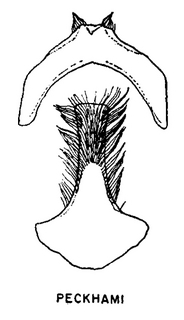
Mitchell, Bees of the Eastern United States, Vol. I, 1960 · 1
Andrena peckhami, figure46d |
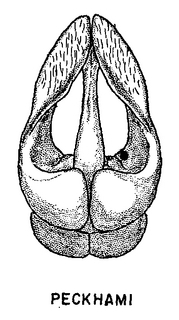
Mitchell, Bees of the Eastern United States, Vol. I, 1960 · 1
Andrena peckhami, figure47a |
|
Overview |
Reprinted by permission of the Regents of the University of California from:
Donovan, B. J. 1977. A revision of North American bees of the subgenus Cnemidandrena (Hymenoptera: Andrenidae). University of California Publications in Entomology: 1-107.
Please report text errors to: leah at discoverlife dot org.
This species can be distinguished from other Cnemidandrena of North America by the inner margins of the compound eyes convergent above throughout their length and black hairs present on the head, mesosoma, and metasoma. The inner margins of the compound eyes convergent above and the males with a very strongly developed genal ridge link this species closely with A. chromotricha.
FEMALE. MEASUREMENTS AND RATIOS. — N = 6; length, 7.9-9.2 mm; width, 2.5-2.9 mm; wing length, M = 2.64 ± 0.053 mm; FL/FW, M = 1.05 ± 0.144; FOVL/FOVW, M = 3.37 ± 0.164.
INTEGUMENTAL COLOR. — Black except as follows: antenna with brown tinge ventrally beyond about second flagellar segment; mandible with apical half red; tegula nearly black, wing veins very dark brown, pterostigma black centrally, peripherally dark brown; wing membrane with apical half moderately cloudy, basal half hyaline; tibial spurs dark yellow, mediotarsi, basitarsi, and basal half of tarsal claws dark brown-yellow; apical half of tarsal claws red; metasomal terga and sterna narrowly hyaline apically, pygidial plate dark red-black.
STRUCTURE. — Scape longer than flagellar segments 1 to 3; flagellar segment 1 longer than flagellar segments 2 plus 3; flagellar segment 2 shorter than flagellar segment 3. Eye less than 4 times longer than wide, with inner margin strongly converging above. Malar space 8 times wider than long. Mandible in repose with one-fourth its length projecting beyond middle of labrum; notch of mandible tooth equidistant between middle of labrum and mandible apex; ventrobasal angle slightly developed. Galea moderately tessellate with dorsal surface equal to or slightly wider than lateral surface. Maxillary palpus reaching to apex of galea; segmental ratio 0.9:1,1:0.8:0.8:0.8:0.8. Labial palpus weakly compressed and curved laterally, segmental ratio 1.6:0.8:0.8:0.9. Labral process with emarginate area weakly recurved, narrowing apically, twice as wide as long, apical emargination very shallow, depth one-seventh length of labral process. Clypeus moderately protuberant, extending below eyes for nearly two-thirds its length, in upper half with a broad, smooth, median, longitudinal, impunctate strip, strip broadening widely in lower half; laterally with large punctures separated by 1 diameter, punctures smaller, closer in upper periphery with moderate shagreening. Supraclypeal area with moderate tessellation obscuring punctation. Genal area wider than eye, posterior margin rounded; a narrow, shiny area near eye with small punctures separated by 1 diameter or more, remainder with widely spaced, larger punctures and reticular shagreening. Vertex above lateral ocellus raised, nearly 1.5 times wider than eye, with medium-sized, deep punctures separated by 1 diameter; moderately tessellate. Supra-antennal area with longitudinal rugulae, and small, obscure, close, interrugal punctures. Facial fovea deeply impressed, well defined, 3.5 times longer than wide, a little wider above than below, rounded at both ends, reaching above to a line through middle of lateral ocellus, reaching below to a line just below antennal fossa.
Pronotum with humeral angle and ridge moderately developed, pronotal suture not well defined, weakly crossing humeral ridge; pronotum above humeral ridge with small punctures, close dorsally, more widely spaced laterally above humeral ridge; whole pronotum with moderate, reticular shagreening. Scutum with medium-sized punctures separated by 2 diameters, with moderate tessellation. Scutellum with anterior two-thirds, except for punctures in median line and laterally, nearly impunctate and smooth, nearly shiny; posterior third with medium-sized punctures and moderate tessellation. Metanotum with anterior two-thirds with weak tessellation, few punctures; posterior third with roughened, crowded punctures and moderate tessellation. Propodeal enclosure with narrow, anterior fringe of weak, irregular rugulae, remainder moderately tessellate with a narrow, median, longitudinal depression; dorsoposterior surface with medium-sized punctures separated by 2 to 3 diameters except punctures closer laterally, moderately tessellate; lateral corbicular areas with widely spaced, medium-sized punctures in less than anterodorsal half, weakly tessellate. Mesepisternum with medium-sized punctures separated by 2 to 4 diameters, moderately tessellate. Metepisternum with small punctures in upper half, lightly shagreened. Mesobasitarsus widest in broad, median area, nearly 3 times longer than wide, slightly wider than metabasitarsus. Metabasitarsus widest near base, less than 4 times longer than wide, two-thirds width of metatibia. Metatibia cuneate, curved ventrally, widest apically, 3.5 times longer than wide. Wing with pterostigma 4 times longer than wide, vein 1st m-cu meets second submarginal cell less than 1 vein width from end of cell.
Metasomal terga 1 to 4 with small to minute punctures on apical margins of discs; tergum 1 with punctures sparse on apical margin of disc, punctures sparsely present laterally and anteriorly on disc; terga 2 to 4 with punctures larger, more numerous apically on discs, closer, with weak tessellation. Tergum 5 with large, deep punctures with rim raised, punctures separated by 1.5 to 2 diameters. Terga 1 to 5 with reticular shagreening. Pygidial plate narrowly rounded apically, lateral edges and broad median area raised, apical half or less impunctate, remainder with small, close punctures. Sternum 1 with small, apical, median emargination; sterna 1 to 6 with medium-sized punctures separated by 2 diameters, except sterna 3 to 6 with broad, median, basal areas impunctate; sterna 1 to 6 with weak, reticular shagreening, nearly shiny.
VESTITURE. — Clypeus with broad, median area naked, hairs white except long, apical hairs dark brown. Facial foveal hairs black; supraantennal hairs white except for a very few black hairs lying over facial foveae. Scutum with widely spaced, erect, black hairs except for intermixed, white hairs anteriorly and laterally. Scutellum with sparse, intermixed, black and white hairs. Propodeal corbicula with widely spaced, long, erect, plumose hairs in anterodorsal half or less. Leg hairs to femora white except apical fimbria of femur brown, tibial scopa with ventral hairs white, remaining leg hairs brown to black. Metasomal tergum 1 with hairs white, disc with long, erect, sparse hairs apically, shorter hairs laterally and anteriorly. Terga 2 to 4 with apical fasciae of short, appressed, white hairs obscuring one-third or less of terga, tergum 2 with fascia poorly developed medially; terga 2 to 4 with short, erect, sparse, black hairs on discs except only present laterally on tergum 2. Tergum 5 with long, dark brown to black hairs posteriorly directed, not obscuring surface. Sterna 1 to 4 with apical fringes weakly developed laterally, absent medially; sterna 2 to 5 with subapical fimbriae well developed laterally, very poorly developed in less than median thirds; sterna 1 to 6 with sparse, erect hairs except impunctate areas of sterna 3 to 5 naked; hairs of sterna 1 to 4 white, hairs of sterna 5 to 6 brown.
MALE. MEASUREMENTS AND RATIOS. — N = 1; length, 8.0 mm; width 2.1 mm; wing length 2.5 mm; FL/FW = 0.9; FS1/FS2 = 1.5.
INTEGUMENTAL COLOR. — Black except as follows: antenna beyond first flagellar segment red-brown ventrally; mandible with apical third red; tibial spurs light yellow; apical half of tarsal claws deep red; tegula shining hyaline medium brown; wing veins and pterostigma dark brown; wing membrane with broad, apical area moderately darkened, remainder hyaline; metasomal terga and sterna moderately widely hyaline apically.
STRUCTURE. — Scape a little shorter than flagellar segments 1 to 3; flagellar segment 1 1.5 times longer than flagellar segment 2, longer than flagellar segment 3. Eye 3 times longer than wide, with inner margin converging strongly above. Malar space as in female. Mandible in repose with more than one-third its length projecting beyond middle of labrum; notch of mandible tooth one-third distance between middle of labrum and mandible apex. Galea as in female. Maxillary palpus with more than apical segment projecting beyond apex of galea; segmental ratio 1.0:1.2:1.0:0.9:0.9:1.1. Labial palpus with basal segment flattened, weakly curved laterally; segmental ratio 1.6:0.9:0.8:1.0. Labral process very strongly reflexed, length more than twice width, apical emargination obscure. Clypeus nearly flat with broad, median area depressed; extending below eyes for more than one-half its length, depressed area irregularly wrinkled, impunctate; remainder of clypeus with medium-sized punctures separated by less than 1 diameter, shiny. Supraclypeal area moderately shagreened with indistinct punctures. Genal area less than twice as wide as eye; from opposite lower third of eye to vertex produced to a very prominent carina, posterior two-thirds or more with very small, widely spaced punctures, remainder impunctate, with very light reticular shagreening, whole area shiny. Vertex above lateral ocellus equals 1.5 ocellar diameters, apex with medium-sized punctures separated by 1 diameter, moderately tessellate. Supra-antennal area as in female; parocular areas as for supra-antennal area.
Pronotum with humeral angle and ridge very well developed, humeral ridge narrowly depressed where crossed by indistinct pronotal suture; dorsally with small punctures separated by 2 diameters; area above humeral ridge shagreened, area below humeral ridge with dorsoventral rugulae, except rugulae poorly developed in lower half, area shiny. Remainder of thorax as in female except as follows: scutellum nearly shiny throughout; propodeum with lateral area with medium-sized punctures in about upper half, weakly tessellate.
Metasomal terga 1 to 5 with small punctures on apical areas of discs and basal halves of depressed areas separated by 2 diameters, except discs with punctures more widely spaced; terga 1 and 2 with fewer and smaller punctures than terga 3 to 5. Sterna 1 to 6 as in female. Sternum 7 (fig. 128) with basal apodemes narrowed anteriorly; apex truncate with lateral corners with sparse hairs. Sternum 8 (fig. 129) with apex broad, neck region merging gradually with basal region; neck area with abundant, long hairs. Gonoforceps (figs. 125 to 127) in dorsal and lateral view strongly ridged; flattened, weakly expanded apically. Penis valves in dorsal and ventral view narrowing gradually from base to apex except apex lobe-like; in lateral view very long, projecting well below gonoforceps.
VESTITURE. — Clypeus with hairs white, sparse, depressed median area naked medially. Vertex with some hairs black. Scutum, scutellum with sparse, erect hairs, most hairs black or brown, remainder white; remainder of thoracic hairs white. Metasomal tergum 1 with very sparse, long, erect hairs apically and laterally, disc nearly naked medially; terga 2 to 4 with apical fasciae of short, white, recumbent hairs; fasciae present on one-third of terga, except absent on median third on tergum 1; discs of terga 2 to 4 laterally with short, black, erect hairs; tergum 5 with disc with longer black hairs laterally, hairs becoming sparse medially. Sternum 1 with vestiture as in female; sterna 2 to 4 with strongly developed apical fringes of long, white hairs, sternum 5 with apical fringe of white hairs strongly developed on lateral aspects, apical fringe of very short hairs on broad median area; sterna 5 and 6 with brown-black hairs.
VARIATION. — In the females the width of the poorly developed median area of the apical fascia of metasomal tergum 2 varies slightly. It is small in the holotype, but much wider in the female paratypes. The sparse, erect hairs apically on tergum 1 show a similar variation, but in both cases increasing wear with age is probably responsible.
Reprinted with permission from: Mitchell, T.B. 1960. Bees of the Eastern United States. North Carolina Agricultural Experiment Station Technical Bulletin No. 141.
FEMALE. — Length 10 mm.; face considerably longer than broad; clypeus convex, median portion somewhat flattened, projecting fully one-half below suborbital line, shining, closely and finely punctate laterally, becoming very sparsely and minutely punctate medially, with a distinct, median, impunctate line above; facial foveae narrow, occupying above little more than half of area between eyes and ocelli (as in robertsonii, fig. 49); space between margin of vertex and lateral ocelli very slightly greater than diameter of ocelli; cheeks very slightly broader than eyes, rounded, very minutely and rather obscurely punctate, surface rather dull; malar space very short but distinct; basal segment of flagellum subequal to 2nd and 3rd combined; process of labrum rather broadly subtriangular, tip narrowly truncate, very slightly emarginate; mandibles of moderate length, with a distinct, inner, subapical tooth; pubescence of head white, rather short, with blackish hairs along vertex; thoracic integument dull, tessellate, very minutely and obscurely punctate, surface of scutellum somewhat more shining; enclosure of propodeum relatively smooth but dull and tessellate; pubescence erect, black and rather short on scutum and scutellum, whitish on pleura and propodeum, whitish in general on legs, but with some fuscous hairs on outer faces of front and middle tibiae; propodeal corbicula long, white, anterior fringe very poorly developed; trochanteral floccus rather long but thin, entirely white; tibial scopa entirely white, rather short and dense, the hairs simple; fore and hind basitarsi distinctly narrower than their respective tibiae, mid basitarsi nearly as broad as their tibiae, slightly broader than hind basitarsi; 2nd submarginal cell very much shorter than 3rd, receiving 1st recurrent near tip; abdominal terga quite smooth, but dull and finely tessellate, punctures inevident, apical margins slightly depressed toward sides, but scarcely at all medially, terga 2-4 with distinct, whitish, apical fasciae, that on tergum 2 rather widely interrupted medially; discal pubescence short and erect, pale on the more basal terga, blackish on terga 3-5.
MALE. — Length 8 mm.; face broad, eyes divergent below, the lower interorbital distance considerably greater than that between apical margin of clypeus and anterior ocellus; lateral ocelli separated from margin of vertex by a space somewhat greater than their diameter; cheeks shining, very broad, with an obscure angle opposite middle of eye, posterior margin from this angle to top of head sharply and conspicuously carinate; clypeus smooth and shining, very much broader than median length, apical margin much narrowed, punctures fine, well separated laterally, becoming very sparse to almost impunctate over median portion of disc below; malar space very short; process of labrum small, rounded, quite markedly protuberant; basal segment of flagellum considerably longer than segment 2 but shorter than 2 and 3 combined; mandibles slender and elongate, somewhat curved, the inner, subapical tooth about opposite lateral angle of clypeal margin; pubescence of head and thorax erect, elongate and rather copious, but not hiding surface, whitish, with intermixed fuscous hairs on dorsum of thorax; scutum smooth but rather dull, punctures very fine and quite sparse, becoming inevident toward anterior margin, scutellum somewhat more shining, punctures minute and obscure, hardly evident; pleura smooth but dull, punctures inevident beneath the rather copious, elongate pubescence; triangle of propodeum poorly defined, smooth but dull, with some very narrow, fine striations across base, lateral surfaces of propodeum smooth but rather dull, propodeal corbicula rather well developed; legs rather dark, becoming reddened apically, pubescence entirely pale; wings lightly infuscated, veins and stigma ferruginous, 2nd submarginal cell very short, receiving 1st recurrent slightly beyond middle; tegulae brownish; abdominal terga smooth but rather dull, punctures exceedingly minute but evident, evenly distributed, rather widely separated, apical impressed areas quite narrow, with punctures hardly evident, discal pubescence short but erect, entirely pale on segments 1 and 2, more fuscous on 3-5, terga 2-4 with loose, white, apical fasciae, more or less interrupted on 2; sternum 7 with a very shallow median emargination, a few obscure setae on each resulting angle; apical portion of sternum 8 rather narrow, very slightly expanded to the abruptly truncate apex, bearing considerable dense pubescence on ventral surface; penis valves extremely slender and elongate, base hardly broader than apex, not quite attaining tip of gonocoxites, which are gradually and rather broadly expanded apically, gonocoxal lobes not produced.
DISTRIBUTION. — Minnesota to Vermont, south to North Carolina; July and August.
FLOWER RECORDS. — Baptisia and Solidago.
|
|
|
Names | |
|
|
| Supported by | |
Updated: 2024-04-26 23:36:10 gmt
|